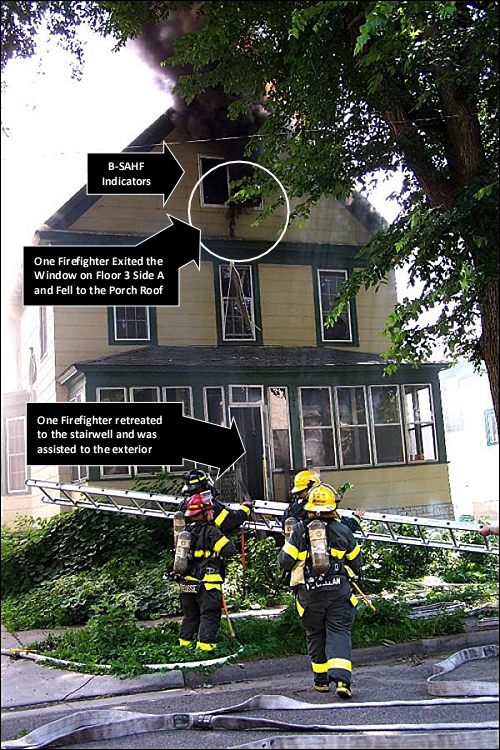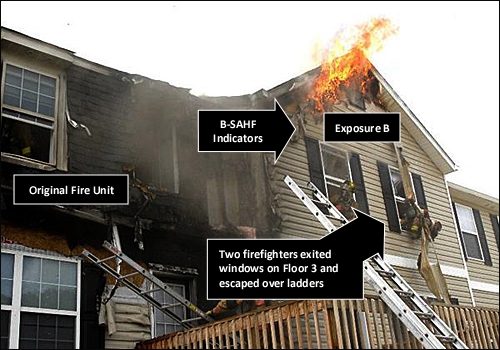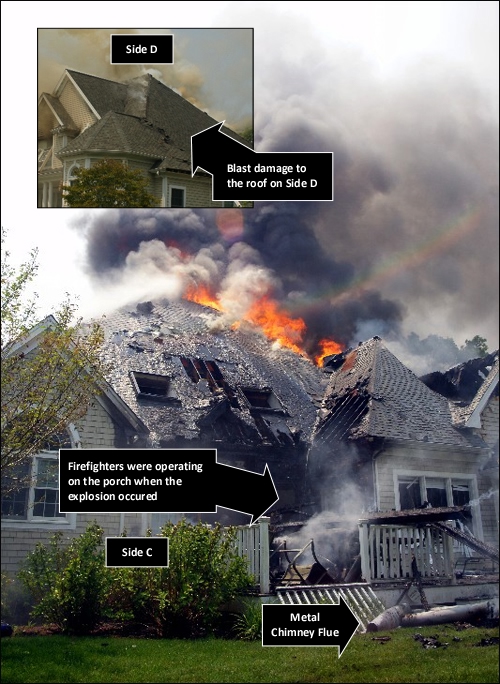Hazards Above
Finally! It has been quite some time since my last post, but the CFBT-US web site and blog have been attacked twice by hackers WordPress and ISP upgrade issues have been a major challenge and it has taken some time to get things back to normal.
A Big Improvement, But More Work is Needed
The Fire Service in the United States saw a considerable reduction in firefighter line-of-duty deaths in 2009. However, our efforts to improve firefighter safety must persist. Recent events reinforce the need to ensure understanding of practical fire dynamics and have the ability to apply this understanding on the fireground.
Three recent incidents involving extreme fire behavior present an opportunity to examine and reflect on the hazards presented by fires and accumulation of excess pyrolizate and unburned products of combustion in attics and other void spaces.
Minneapolis, MN Residential Fire
At 1130 hours on Saturday, July 3, 2010 Minneapolis firefighters responded to a residential fire at 1082 17th Avenue SE. First arriving companies observed light smoke and flames showing from a two and one-half story wood-frame home. A crew opening up the kneewall on the A/D corner of Floor 3 was trapped on the third floor by rapid fire progress.
Note: Photo by Steve Skar
A department spokesperson indicated that as they opened up the walls “it flashed over on them”. News reports indicated that the blast threw Firefighter Jacob LaFerriere, across the room and that he was able to locate a window, where he exited and dropped to the porch roof, one floor below. Capt. Dennis Mack was able to retreat into the stairwell where he was assisted to the exterior by other crews operating on the fireground (Mathews, 2010; Radomski & Theisen, 2010).
News reports also reported that a witness stated that the “flashover was quite loud and within seconds heavy fire was venting from the attic area” (Mathews, 2010). A later statements by department spokespersons indicated introduction of oxygen when the wall was opened resulted in the flashover (Porter, 2010) and that a burst of flames blew out the south side of the roof (Radomski & Theisen, 2010).
Firefighter Jacob LaFerriere suffered third degree burns on his arms and upper body. Capt. Dennis Mack suffered second degree burns (Radomski & Theisen, 2010) and are as of Sunday, July 4 were in satisfactory condition in the Hennepin County Medical Center Burn Unit.
Harrisonburg, VA Townhouse Fire
On June 24, 2010 Harrisonburg, Virginia firefighters responded to an apartment fire off Chestnut Ridge Drive. First arriving companies encountered a fire in a townhouse style, wood frame apartment. Investigating possible extension into Exposure Bravo, Firefighters Chad Smith and Bradly Clark observed smoke and then flames in the attic. They called for a hoseline, but when the pulled the ceiling, conditions worsened as the room ignited. Both firefighters escaped through a second floor window (head first, onto ladders placed by exterior crews). Four other firefighters were inside Exposure B when the extreme fire behavior occurred. Two received second degree burns, one was treated for heat exhaustion, and the fourth was uninjured (Firehouse.com News, 2010; WHSV, 2020). Department spokespersons indicated that a backdraft occurred when fire gases built up in the attic.
Note: Photo by Allen Litten
Sandwich MA Residential Fire
At around noon on Memorial Day, Sandwich, Massachusetts firefighters responded to a residential fire at 15 Open Trail Road. On arrival they found a 5,000 ft2 (464 m2) wood frame single-family dwelling with a fire on Side C (exterior) with extension into the home. Firefighters Daniel Keane and Lee Burrill stretched a handline through the door on Side A, knocking down the fire and extending the line out onto a deck on Side C. Fire was extending through a void containing a metal chimney flue on the exterior of the building. The crew on the hoseline was making good progress until they hit the soffit with a straight stream and an explosion occurred. The force of the blast knocked the crew over the deck railing and caused significant structural damage. Firefighter Keane suffered fractures of his neck and back while Firefighter Burrill experienced a severely fractured ankle (Fraser, 2010; D LeBlanc personal communication June 2010).
Note: Photos by Britt Crosby (http://www.capecodfd.com/)
Questions
One of these fires occurred in an older home of legacy construction, the other two occurred in relatively new buildings. One was a large contemporary home, likely with an open floor plan and large attic/trussloft voids. The other two occurred in buildings with smaller void spaces in the attic/trussloft.
- What is similar about these incidents and what is different?
- Based on the limited information currently available, what phenomena do you think occurred in each of the cases? What leads you to this conclusion?
- What indicators might have pointed to the potential for extreme fire behavior in each of these incidents?
- How might building construction have influenced fire dynamics and potential for extreme fire behavior in these incidents?
- What hazards are presented by fires in attics/trusslofts and what tactics may be safe and effective to mitigate those hazards?
Late Breaking Information
Two firefighters and an officer from the Wharton Fire Department were trapped by rapid fire progress in a commercial fire at the Maxim Production Company in Boling, TX on July 3, 2010. The crew had advanced a hoseline into the 35,000 ft2 (3252 m2) egg processing plant to cut off fire extension when they encountered rapidly worsening fire conditions. The two firefighters were able to escape, but Captain Thomas Araguz III was trapped and killed (Statter, D., 2010). More information will be provided on this incident as it becomes available.
References
Mathews, P. (2010). Two Minn. ffs burned in flashover. Retrieved July 4, 2010 from http://www.firehouse.com/news/top-headlines/two-minneapolis-firefighters-burned-flashover
Radomski, L & Theisen, S. (2010). Firefighters hospitalized after flashover identified. Retrieved July 4, 2010 from http://kstp.com/news/stories/S1637495.shtml?cat=1
Porter, K. (2010). 2 firefighters burned in Mpls. fire ID’d. Retrieved July 5, 2010 from http://www.kare11.com/news/news_article.aspx?storyid=856556&catid=396
WHSV. (2010) Harrisonburg firefighters talk about their close call. Retrieved July 5, 2010 from http://www.whsv.com/home/headlines/97127924.html
Firehouse.com News. (2010). Harrisonburg, Va. firefighters forced to bail out. Retrieved July 5, 2010 from http://www.firehouse.com/showcase/photostory/harrisburg-va-firefighters-have-bail-out
Fraser, D. (2010). Mass. firefighters thrown more than 30 Ft. by blast. Retrieved July 5, 2010 from http://www.firehouse.com/news/top-headlines/blast-throws-mass-firefighters-more-30-feet
Statter, D. (2010). Update: Captain Thomas Araguz III killed during 4-alarm fire at egg plant in Boling, Texas. http://statter911.com/2010/07/04/firefighter-killed-during-4-alarm-fire-at-egg-plant-details-from-wharton-county-texas/
Tags: backdraft, Extreme Fire Behavior, fire behavior indicators, firefighter fatality, firefighter injury, firefighter LODD, flashover, smoke explosion, vent controlled fire






July 19th, 2010 at 06:54
[…] « Hazards Above […]
July 25th, 2010 at 12:13
[…] last two posts (Hazards Above, Hazards Above: Part 2)examined a series of incidents involving firefighter injuries or near miss […]